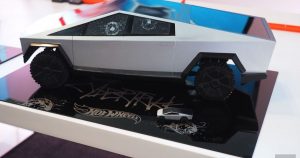Display
An area where the Elite Dragonfly falls somewhat short, though, is its display. The low-power full HD panel on my review unit tops out at 400 nits, which is plenty bright for indoor use. But under sunlight, it got much harder to see, especially when trying to watch dimly lit scenes in The Haunting of Hill House. There’s also a model with a UHD 550-nit panel and one with HP’s SureView privacy filter built in that goes up to 1,000 nits. Personally I’d opt for the latter version. It’s nice when you’re, say, working on an embargoed post in the middle seat on the way to CES, to be able to block nosy seatmates from seeing your screen with the push of a button.
The base model’s screen is still sharp and vivid enough for YouTube videos or light Netflixing. If you’re looking for a more cinematic experience, though, you might prefer something with a higher resolution and better contrast ratios like a Dell XPS 13 or a Galaxy Book Flex. Although we have yet to test the latter system out and can’t vouch for its performance.
Performance and battery life
You can spec the Elite Dragonfly with anything from an eighth-generation Intel Core i3 to an i7 with vPro enterprise features. My review unit came with a Core i7 chip, which was more than enough for my daily workflow, which mostly consists of Slack, Telegram, batch photo conversion, light image editing and jumping between dozens of open Chrome tabs.
Graphics performance is where the Elite Dragonfly lags the competition, though. Its Intel UHD 620 processor isn’t powerful enough for even light gaming or video editing. It took two minutes and forty seconds to convert a one-minute 4K movie trailer to 1080p on Handbrake, which is almost a full minute slower than the Surface Laptop 3. During my benchmarking, the Elite Dragonfly got warm, but it never ran too hot and the fan noise was barely noticeable, which is particularly impressive given its compact body.
I’ve also been surprised by the Elite Dragonfly’s battery life. I’ve taken it with me to meetings, and to get work done at restaurants, and the battery indicator has not budged. Though HP said the laptop is supposed to last up to 16.5 hours, it only clocked 13 hours and 11 minutes on our battery test, which is worse than the XPS 13 2-in-1 and ThinkPad X1 Carbon, but more than the XPS 13 clamshell. That number is likely to be lower if you use a model with a brighter, sharper screen, and if you were browsing the web over an LTE connection.
Wrap-up
It’s tough to compare the Elite Dragonfly to other laptops, as few business convertibles today are this thin and light. You could get a ThinkPad X1 Yoga, which would provide a better typing experience, but the Elite Dragonfly just looks and feels so much more modern. You could also opt for a similarly specced Dell XPS 13 2-in-1 for around the same price, which offers a better screen with HDR support. But the Elite Dragonfly offers way more ports, and personally, I prefer HP’s design.
At the end of the day, the Elite Dragonfly is a solid convertible that, despite its business branding, might just hold an appeal to mainstream laptop shoppers.
In this article:
gadgetry, gadgets, gear, hp, hp elite dragonfly, laptop, notebook, personal computing, personalcomputing, review, windows
All products recommended by Engadget are selected by our editorial team, independent of our parent company. Some of our stories include affiliate links. If you buy something through one of these links, we may earn an affiliate commission.

Comments

67
Shares




